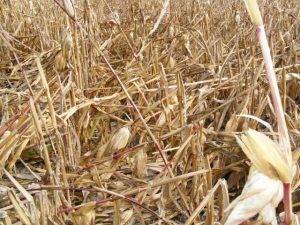Stalk Lodging
Stalk lodging can lead to reduced yield and grain quality. Lodging refers to the breakage of the stalk below the ear and is often connected with stalk rots, soil-borne pathogens and other environmental stressors that occur after pollination.
Causes of Stalk Lodging
Carbohydrate demand during grain fill is the primary driver of stalk lodging. When carbohydrate reserves in corn leaves are depleted during ear development, the plant will begin sourcing the macronutrient from stalks and roots. Environmental stresses can feed into this cycle. For example, warm weather and high temperatures increase plant growth which can lead to high demand for carbohydrates.
While energy demand during grain fill is the primary cause of lodging, fungal pathogens can reduce stalk vigor. Stalk rot pathogens can also weaken stalks and are another major cause of lodging. Generally, if more than 10 to 15% of stalks exhibit rotting, stalk lodging is likely to be a significant problem.
As it relates to weather, high winds and heavy rainfall can also cause stalks to become physiologically weak and eventually lodge. Injuries from hail or frost damage, or insect feeding that creates lesions on leaves, can reduce the amount of energy created by plants. This leads to a higher use of stalk carbohydrate reserves.
Nutrient deficiencies are also a major cause of stalk lodging. Excess nitrogen and low levels of potassium have been associated with reduced stalk quality. Maintaining sufficient potassium levels in corn is especially important as it is the building block for leaf and stalk tissue.
Scouting and Treatment Options
When scouting for stalk lodging, choose ten consecutive plants across ten different areas of the field. Check for signs of lodging by pinching the stalk at the first or second internode above the ground, or by pushing the plant over 8 to 12 inches at ear level. If the plant fails to stay standing upon exerting force, it is considered lodged.
Adjust your harvest plan to harvest lodged corn first before lodging becomes more widespread. Selecting the right corn hybrid for your farm can mitigate issues with insect feeding that would otherwise reduce stalk quality. The level of resistance to stalk lodging among hybrids is highly variant and some have genetically stronger stalks than others. Be sure to consult with your local Latham representative to determine the best management strategy for stalk lodging.
